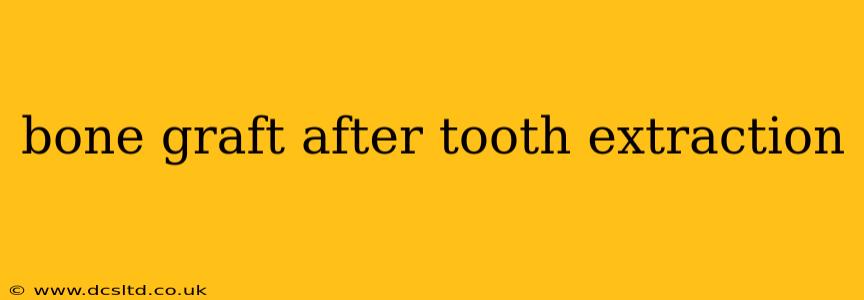Losing a tooth can be upsetting, but it's crucial to understand the potential need for a bone graft after tooth extraction. This procedure helps preserve your jawbone's structure and ensures successful future dental implants or other restorative treatments. This comprehensive guide will address common questions and concerns surrounding bone grafting following tooth extraction.
What is a bone graft after tooth extraction?
A bone graft after tooth extraction is a surgical procedure where bone material is added to the jawbone socket where a tooth was removed. This is often necessary because when a tooth is extracted, the jawbone loses its stimulation and begins to resorb (dissolve). This bone loss can make it difficult or impossible to place dental implants later, as implants require a sufficient amount of healthy bone to anchor securely. The grafted bone material acts as a scaffold, promoting new bone growth and restoring the jawbone's volume and density.
Why is a bone graft necessary after tooth extraction?
Several factors determine the need for a bone graft following tooth extraction. These include:
- Extent of bone loss: Significant bone loss around the extraction site might necessitate a bone graft.
- Type of tooth extraction: Complex extractions, those involving significant bone removal, often require grafts.
- Planned future treatment: If you plan to get dental implants in the future, a bone graft is often necessary to provide sufficient support for the implant.
- Overall jawbone density: Patients with naturally low bone density may require a bone graft even after a straightforward extraction.
- Time since extraction: The longer the gap between extraction and implant placement, the greater the likelihood of bone resorption and the need for a graft.
What are the different types of bone grafts?
Several types of bone grafts are used, each with its advantages and disadvantages:
- Autografts: Bone taken from another area of your own body (e.g., hip or chin). These are the gold standard due to the body's natural acceptance, but they involve a second surgical site.
- Allografts: Bone taken from a deceased donor. Rigorous screening ensures safety, and they minimize the need for a second surgery.
- Xenografts: Bone taken from another species (e.g., cow). These are readily available but might have a higher risk of rejection compared to autografts or allografts.
- Synthetic grafts: Made from materials like hydroxyapatite or calcium phosphate. These are biocompatible and offer predictable results.
What are the risks and complications of a bone graft?
As with any surgical procedure, bone grafting carries potential risks and complications, including:
- Infection: Although rare with proper sterile techniques, infection is a possibility.
- Nerve damage: In rare cases, nerves near the surgical site might be damaged, causing numbness or tingling.
- Bleeding: Some bleeding is normal, but excessive bleeding is uncommon.
- Graft rejection: This is less likely with autografts but can occur with other types of grafts.
- Pain and swelling: These are common in the days following surgery and are typically managed with medication.
How long does it take to recover from a bone graft?
Recovery time varies depending on the type and extent of the graft. Expect some swelling, bruising, and discomfort for a few days to weeks. Your dentist or oral surgeon will provide specific post-operative instructions to ensure a smooth recovery. Full bone healing can take several months.
How much does a bone graft cost?
The cost of a bone graft depends on several factors, including the type of graft, the amount of bone needed, and your geographic location. Consult with your dentist or oral surgeon to get a personalized cost estimate.
Is a bone graft painful?
Most patients describe the procedure as manageable with local anesthesia. Post-operative pain is usually mild and controllable with over-the-counter or prescription pain relievers.
Can I get a bone graft without dental implants?
Yes, a bone graft can be performed even if you don't plan on getting dental implants immediately. This helps preserve your jawbone structure, preventing further bone loss. It's a preventative measure to maintain oral health.
What happens if I don't get a bone graft after tooth extraction?
Without a bone graft, continued bone resorption can occur, leading to a sunken appearance in the jaw, difficulty chewing, and the inability to place dental implants in the future. This can compromise your overall oral health and facial aesthetics.
This information is intended for educational purposes only and does not constitute medical advice. It's crucial to consult with a qualified dentist or oral surgeon to discuss your individual needs and determine the best course of action for your specific situation. They can assess your bone density, planned treatment, and overall health to recommend the most appropriate treatment plan.
